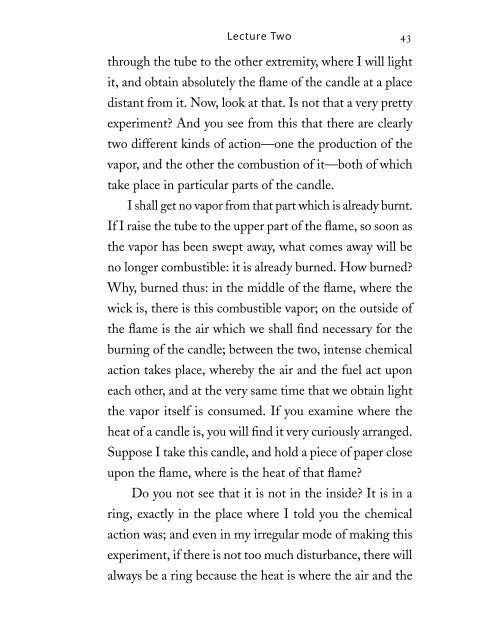Michael Faraday's The Chemical History of a Candle
Michael Faraday's The Chemical History of a Candle With Guides to Lectures, Teaching Guides & Student Activities by Bill Hammack & Dos DeCoste
Michael Faraday's The Chemical History of a Candle With Guides to Lectures, Teaching Guides & Student Activities by Bill Hammack & Dos DeCoste
Create successful ePaper yourself
Turn your PDF publications into a flip-book with our unique Google optimized e-Paper software.
Lecture Two<br />
43<br />
through the tube to the other extremity, where I will light<br />
it, and obtain absolutely the flame <strong>of</strong> the candle at a place<br />
distant from it. Now, look at that. Is not that a very pretty<br />
experiment? And you see from this that there are clearly<br />
two different kinds <strong>of</strong> action—one the production <strong>of</strong> the<br />
vapor, and the other the combustion <strong>of</strong> it—both <strong>of</strong> which<br />
take place in particular parts <strong>of</strong> the candle.<br />
I shall get no vapor from that part which is already burnt.<br />
If I raise the tube to the upper part <strong>of</strong> the flame, so soon as<br />
the vapor has been swept away, what comes away will be<br />
no longer combustible: it is already burned. How burned?<br />
Why, burned thus: in the middle <strong>of</strong> the flame, where the<br />
wick is, there is this combustible vapor; on the outside <strong>of</strong><br />
the flame is the air which we shall find necessary for the<br />
burning <strong>of</strong> the candle; between the two, intense chemical<br />
action takes place, whereby the air and the fuel act upon<br />
each other, and at the very same time that we obtain light<br />
the vapor itself is consumed. If you examine where the<br />
heat <strong>of</strong> a candle is, you will find it very curiously arranged.<br />
Suppose I take this candle, and hold a piece <strong>of</strong> paper close<br />
upon the flame, where is the heat <strong>of</strong> that flame?<br />
Do you not see that it is not in the inside? It is in a<br />
ring, exactly in the place where I told you the chemical<br />
action was; and even in my irregular mode <strong>of</strong> making this<br />
experiment, if there is not too much disturbance, there will<br />
always be a ring because the heat is where the air and the


